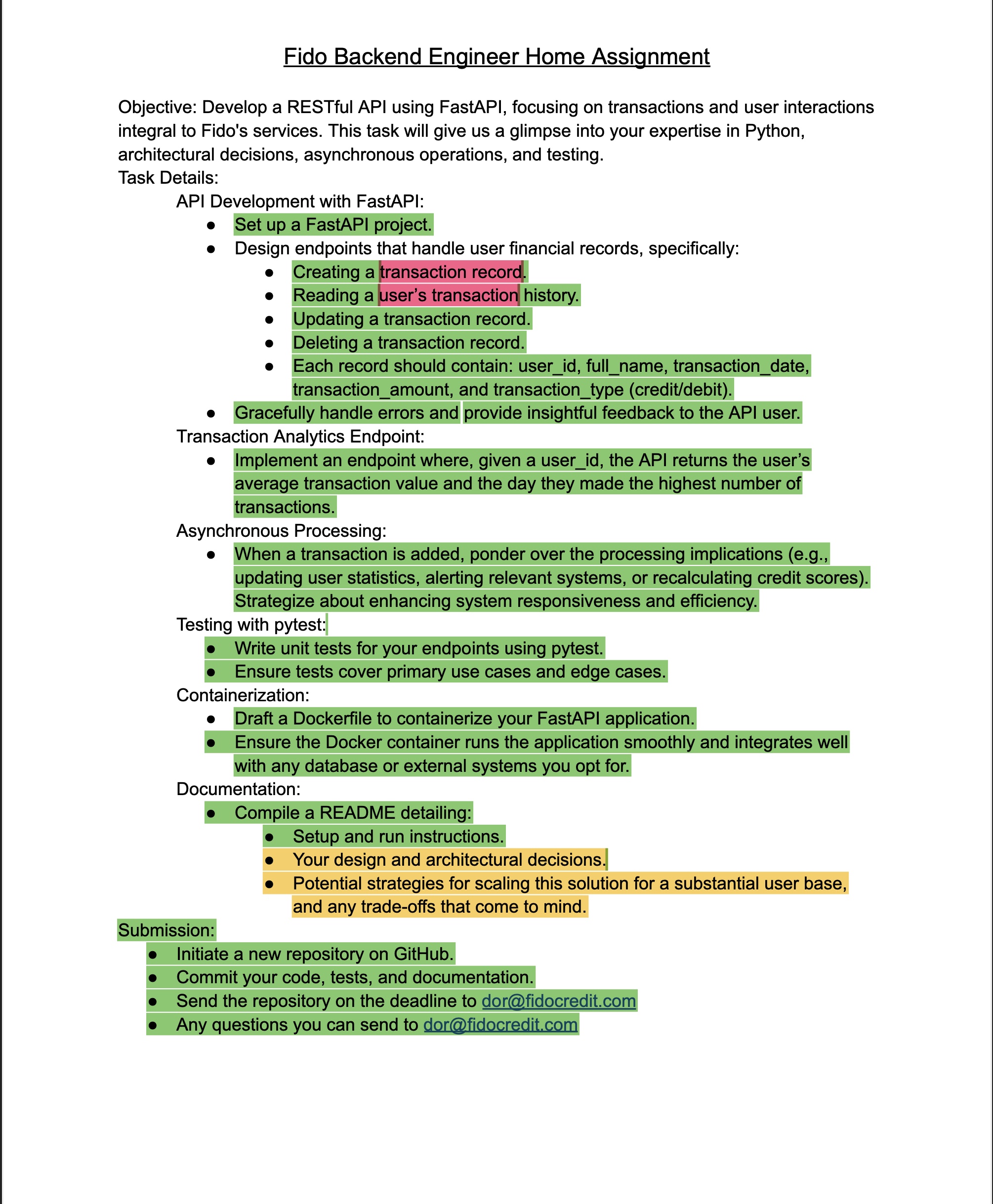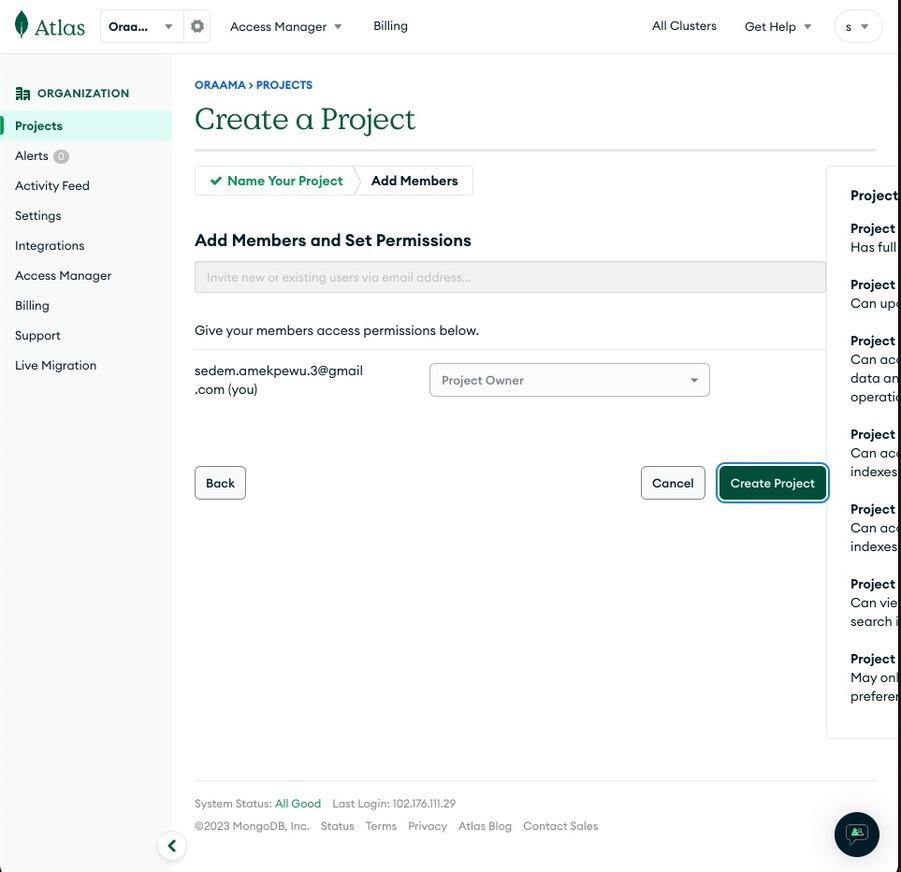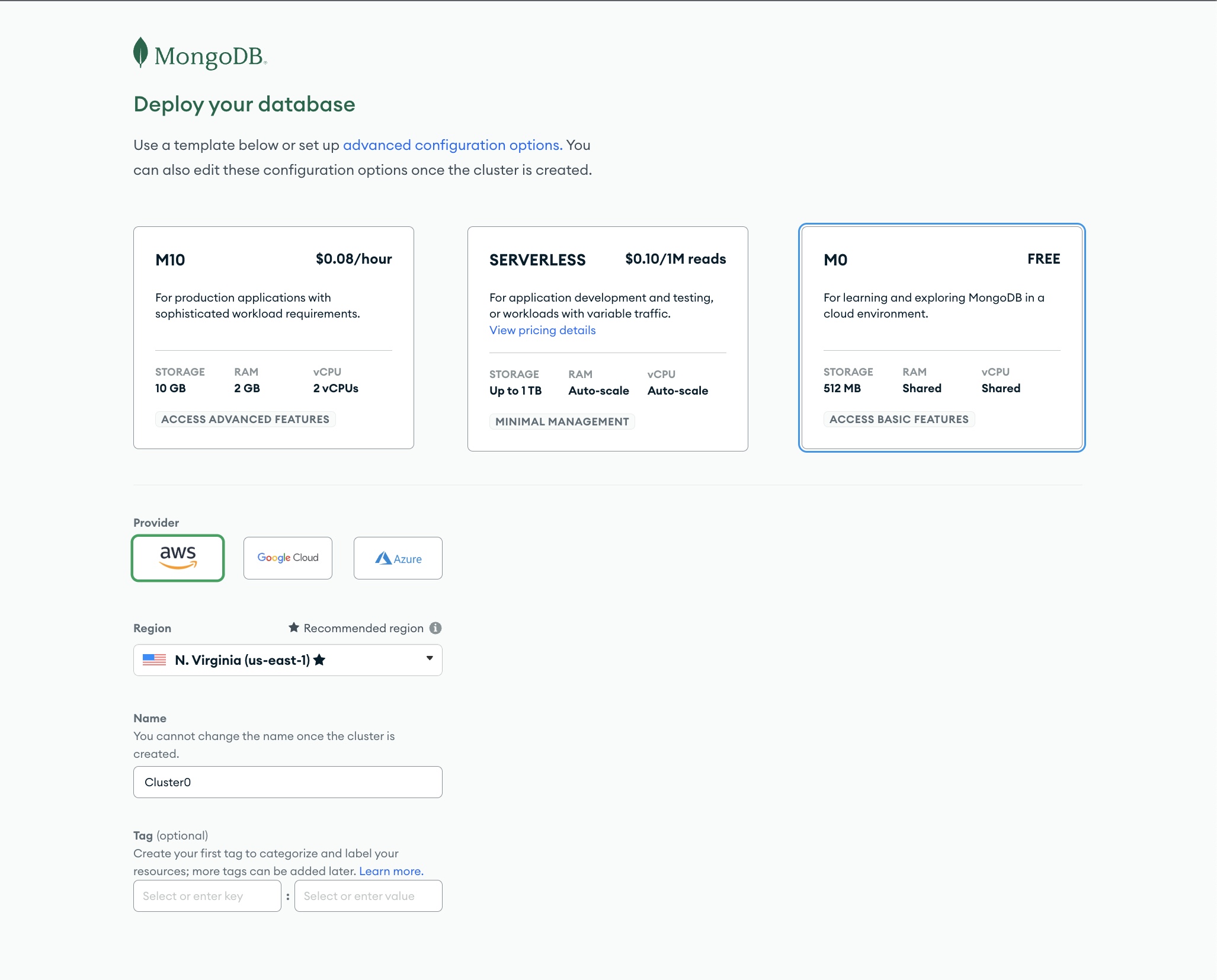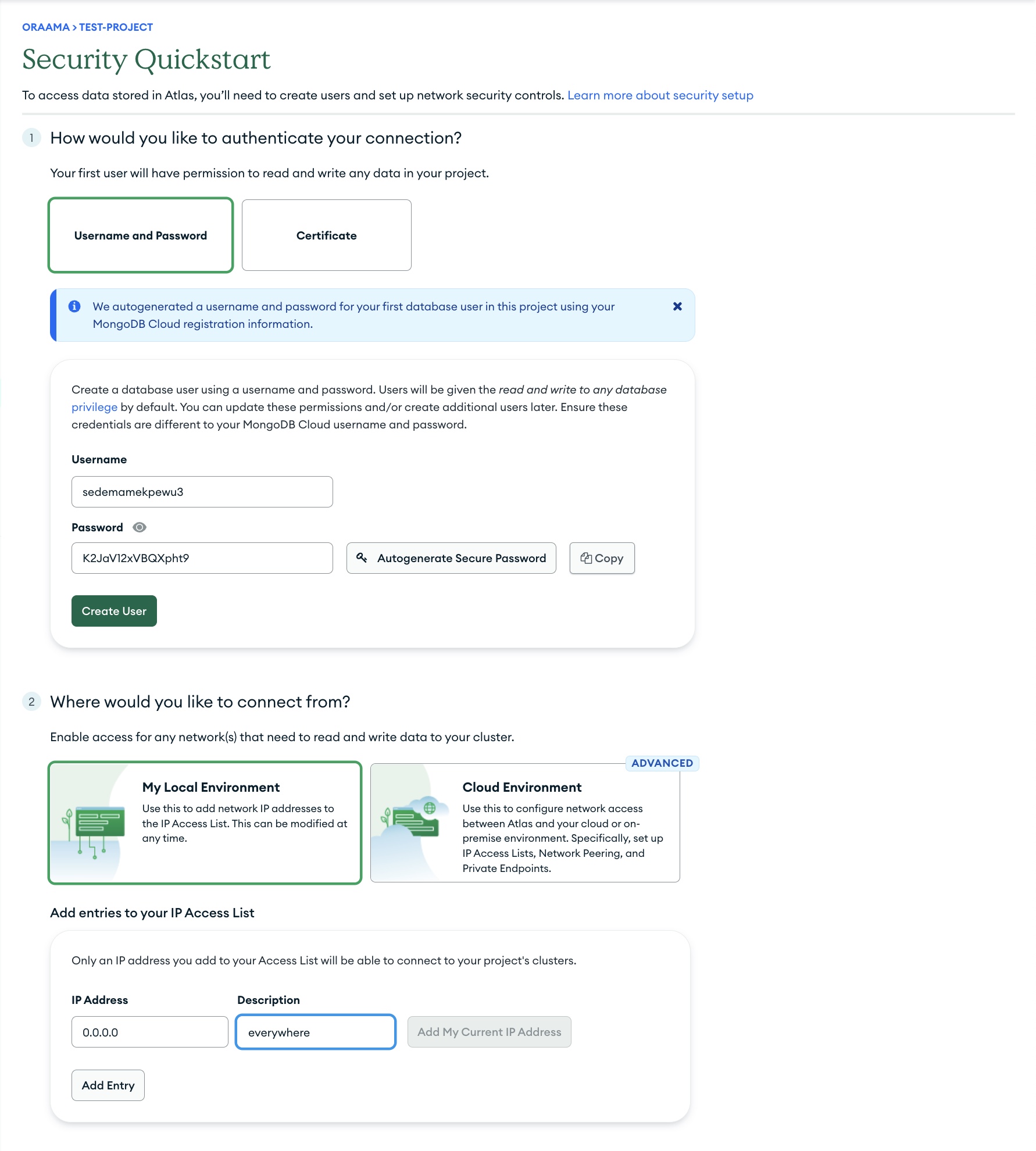- To run this program, you need to create add the following environment variables.
// Specify your MongoDB credentials.
$ export MONGO_DB_NAME=
$ export MONGO_URI=
// Specify your Twilio credentials to send SMS.
$ export TWILIO_ACCOUNT_SID=
$ export TWILIO_AUTH_TOKEN=
-
Clone the repository:
git clone https://github.com/SedemQuame/fastapi-restapi-assignment.gitor download as a zip file and extract it on your computer. -
Change directory into the root directory of this project.
-
Setup a virtual environment for this project, by running the command
virtualenv venv. -
Activate the virtual environment, by running the following commands
For Linux/Mac
source venv/bin/activate
For Windows
source venv/Scripts/activate
-
Install the various requirements to run this project by running the command
pip install -r requirements.txt -
Start the fast-api server locally by using the following command.
uvicorn app.index:app --reload
In this section I will cover how to build this docker application from scratch and deploy it to a docker repository, in this case docker hub.
- Navigate to the root of this project's directory, where the Dockerfile is located.
- Make sure docker is running on the computer.
- Build a docker image, by running the command
docker build -t fido-fastapi-app:latest . - The new image can be run locally by using the command.
docker run -p 8000:8000 fido-fastapi-app:latest, which exposes the application via port 8000. Now, you should be able to access this application by opening a web browser and navigating to http://localhost:8000. - Pushing to the docker registry is done by login into docker hub from CLI by running
docker login. - Tagging the image with your user name for easy identification.
docker tag fido-fastapi-app:latest sedemquame/fido-fastapi-app:latest. - The resulting image was pushed using the command
docker push sedemquame/fido-fastapi-app:latest.
- Pulling the container from the docker registry.
docker pull sedemquame/fido-fastapi-app:latest - To run the downloaded container, use the container
docker run -p 8000:8000 sedemquame/fido-fastapi-app:latest, this can also be access from http://localhost:8000
- I decided to use the MVC design pattern for this project, but later changed it slightly such that the controllers and routers were configured in same file.
- The first thing I did for this project was to understand the various models that needed to be used, and how to set them up correctly, since this is the foundation for efficiency.
- From the spec sheet, I noticed that we were concerned with two entities the user and transactions, the images below shows how these entities were modelled.
USER MODEL
from pydantic import BaseModel
from typing import Dict, List
class User(BaseModel):
name: str
email: str
phone_number: str
password: str
balance: float
transactions: Dict[str, List[float]] = {}
credit_score: float = 0.0
average_transaction_value: float = 0.0
total_number_of_transactions: float = 0.0
total_amount_transacted : float = 0.0
date_with_highest_transaction: str
class Config:
orm_mode = True
TRANSACTION MODEL
from pydantic import BaseModel
from enum import Enum
from datetime import datetime
class TransactionType(str, Enum):
credit = "credit"
debit = "debit"
class Transaction(BaseModel):
user_id: str
full_name: str
transaction_date: datetime
transaction_amount: float
transaction_type: TransactionType
class Config:
orm_mode = True
I used the composition approach to relate these two models. That is to say a user model is capable of initiating a transaction, or a transaction is created and associated to a user.
The endpoints for transactions and users were set up in routes/transaction_route.py and routes/user_route.py respectively, and then included at the entry point of the main app.
from fastapi import FastAPI
from routes.user_route import user_router
from routes.transaction_route import transaction_router
app = FastAPI()
app.include_router(user_router, prefix="/api")
app.include_router(transaction_router, prefix="/api")
To see a detailed view of the endpoints created for this project. Please see the published postman documentation https://documenter.getpostman.com/view/9702163/2s9Y5R3mz9
To see the endpoints in action, please join this postman workspace. https://app.getpostman.com/join-team?invite_code=07c3efafac0c6e2b10efc6d42e6fe73c&target_code=06e8316ff3ac989c6cd6fa853f98fac9
[SIDE NOTE]: Fastapi has a documentation section that can be seen by just visting the url http://localhost:8000/docs (if using the docker container)
This project uses an external mongoDB database, provisioned on a free cluster on mongo atlas.
A look at the process of creating the fastapi
-
Create a new database project
-
Setup the user permissions
-
Setting up the database cluster
-
Setup the passwords for the various roles and whitelist all ip addresses
Connection to the database is done in config.db.py.
This manages the database connection.
client = MongoClient(
os.getenv("MONGO_URI")
)
conn = client.get_database(os.getenv("MONGO_DB_NAME"))
I handled errors that might occur in this program by doing the following.
- I wrapped, the code for all routes in try catch blocks and returned an appropriate message for anticipated and generic errors.
- I used defensive programming to handle some of the errors i anticipated, these include
- We cannot create transactions linking to a user.
- When calculating the average transaction value, I made sure to prevent division by zero errors by returning 0, when the length of the transaction list is 0.
The transaction analytics endpoint, was an interesting task to build and was the point I faced the most challenge. My approach, was to calculate the statistics of the user, when a new transaction is created, and store this data in the the User model, this way when the endpoint for this resource is created, we do not do any calculations by simply lookup the required values.
See the code below to understand
@transaction_router.post("/create_transaction/", response_model=TransactionResponse)
async def create_transaction(transaction: Transaction):
try:
transaction_dict = transaction.model_dump()
inserted_transaction = conn.transaction.insert_one(transaction_dict)
if inserted_transaction.inserted_id:
send_sms(transaction_dict)
update_user_stats(transaction_dict)
return TransactionResponse(**transaction_dict)
else:
raise HTTPException(status_code=500, detail="Failed to create transaction")
except Exception as e:
error_message = "An error occurred while creating the transaction."
return ErrorResponse(detail=error_message)
The code below shows the implementation for calculating the user's statistics. This approach makes calculating the scores much easier, since the required values are calculated and stored at every run.
The benefit is that the {{host}}/api/transaction_analytics/ is much faster at returning the required details, but we now have to store more data and run this operation in the background everytime, which might increase cost.
def update_user_stats(transaction: Dict):
# some code
user["total_number_of_transactions"] += 1
user["total_amount_transacted"] += abs(transaction_amount)
user["average_transaction_value"] = user["total_amount_transacted"] / user["total_number_of_transactions"]
user["date_with_highest_transaction"] = find_date_with_highest_amount(user)
# update user
conn.user.find_one_and_update({"_id": ObjectId(user_id)}, {"$set": dict(user)})
For this project when a transaction is added there are some critical housekeeping activities we need to do, these are.
- Inserting the transactions into the db which is the main task. [MAIN TASK]
- Sending and sms to the user which is done asynchronously, using the Twilio library
- Calculating and updating the stats of the related user which is done asynchronously.
To achieve this, I first decided to use redis and celery to create an asynchronous worker, which these tasks will be forwarded to, but i run into some setup challenges, which led to me changing my approach and deciding to use fastapi's in-built Background tasks class.
@transaction_router.post("/create_transaction/", response_model=TransactionResponse)
async def create_transaction(transaction: Transaction, background_tasks: BackgroundTasks):
try:
transaction_dict = transaction.model_dump()
inserted_transaction = conn.transaction.insert_one(transaction_dict)
if inserted_transaction.inserted_id:
# Create background tasks
#1. Send an sms to the user
background_tasks.add_task(send_sms, transaction_dict)
#2. Calculate new stats and update the user information, to enable easy and fast lookup
background_tasks.add_task(update_user_stats, transaction_dict)
return TransactionResponse(**transaction_dict)
else:
raise HTTPException(status_code=500, detail="Failed to create transaction")
except Exception as e:
error_message = "An error occurred while creating the transaction."
return ErrorResponse(detail=error_message)
Below are the steps I took when architecting this system.
- Identity the key components of the system.
- Formulate the models for these components.
- Define the interactions of each model.
- Identifying the flow of data.
I identified the key components of the system (highlighted in red)

I then created the relevant models to support the key components of the system. These models were
- The User Model
- The Transaction Model
I then modelled a relationship between these two models, using the composition approach. From the requirement spec sheet, I realised that user model, is a composition of transactions or (a user "has-a" transaction).
These were the interactions I noted.
- CRUD functionality for user models.
- CRUD functionality for transaction models.
I think the following are some strategies that when implemented correctly, could help scale this application to a large number of users.
- Load balancing, where incoming traffic is distributed across multiple instances of the application, this would prevent a single server from being overwhelmed.
- Database indexing and optimization, this application relies heavily on a mongodb database, to perform CRUD operations. An optimized database, would return the data needed faster, leading to reduced latency.
- Asynchronous processing, for tasks that can be deferred till later, like calculating the user statistics, i think those tasks can be passed on to a task queue using celery and redis, but more time sensitive tasks like sending the sms alert can use background processing.
- Properly configure celery and redis server, to run tasks asynchronously in the background.
- Optimize the provisioned database, to reduce latency when performing CRUD operations.
- Make this program more resilient to unexpected user inputs.
- Add API authentication, using JWT tokens, to improve security.
- Find a proper formulat for calculating the credit, currently what is done is just finding the average of absolute transactions and scaling it from 1 to 5.




